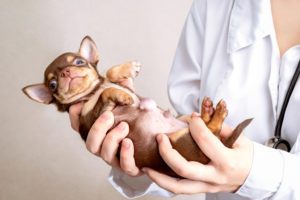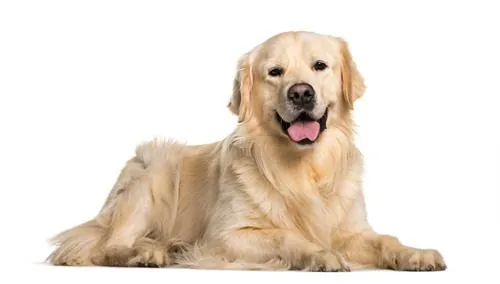Umbilical Hernia in Dogs: Symptoms and Treatment
Every year thousands of puppies are born around the world. Many of those puppies will suffer from an umbilical hernia in their first few weeks of life.
What is an umbilical hernia?
An umbilical hernia in dogs is a protrusion of fat or tissue under the skin in the area where the umbilical cord linked the puppy to the mother. When the puppy is developing in the womb, the umbilical cord on the outside of the puppy’s abdomen attaches to the placenta that provides nourishment to the fetus. After birth, this umbilical cord dries up and falls away, leaving just a healed area in the abdominal wall surrounded by a little ring of tissue . In normal healing, this area should heal completely, leaving a tiny belly button. In some puppies, the ring of tissue in the abdominal wall fails to completely close, even though the skin heals just fine. This leaves an opening in the abdomen that can allow fat, bits of extra tissue, and sections of internal organs to escape. As this happens, these things bulge under the healed skin. This leads to a lump or mass where the belly button should be and is called an umbilical hernia.
Recognizing an umbilical hernia
When you take your puppy in for his or her first exam, the veterinarian will gently press on the area around the belly button. This palpation is meant to check the internal organs, but will also identify any lumps or bumps under the skin. A soft mass at the location of the belly button indicates an umbilical hernia.
In some cases, the herniated area will be large enough to be visible without a physical exam. In some puppies, the hernia appears as a bulge or bump on the pup’s belly. The size of the lump determines which treatment options the veterinarian might recommend.

Dangers of umbilical hernias
In most cases, the puppy will be just fine with a small umbilical hernia. Think of it as a protruding belly button on a human, an outie instead of an innie. This happens when the skin heals, but a tiny sliver of the umbilical opening remains unclosed inside the body. Over time this opening may heal on its own. In some instances, the vet may choose to treat the hernia.
The risks multiply when the opening or ring of tissue under the skin is larger than a fraction of an inch. In larger openings, a portion of the intestines can drop through the opening and not re enter the body through the same opening, on its own. This can lead to a pinched intestine- a condition that cuts off the blood supply to the intestine, causes the inability to feed and pass waste, and causes a build up of toxins in the body. In this case, the umbilical hernia will put the puppy’s life in danger and could eventually kill the animal if not treated.
Treating the umbilical hernia
If the hernia is very small, the veterinarian will likely recommend waiting a few months to see if it heals on its own. This is the optimal solution to the problem.
If the hernia is larger than a few centimeters, the vet may instruct you to keep a close eye on your pet for any signs of intestinal distress.
Symptoms of distress include:
Continued crying
Fever
Lethargy
Refusing to eat
Not passing fecal waste
Vomiting
Enlargement of the hernia area
If any of these symptoms appear the vet may recommend immediate surgery to repair the hernia and place the intestines back in the correct place. In the event that a portion of the intestines was severely damaged by lack of blood flow or twisting, it may be necessary to also repair that damage. This would be considered major surgery and require an extensive recovery time.
In most cases, however, repairing an umbilical hernia in a puppy can wait until the puppy is four to five months of age and ready for spay or neuter surgery. When the vet does the sterilization surgery, it is convenient to do the hernia repair at the same time. This is easier on the dog because it only requires being anesthetized one time, rather than undergoing repeated surgeries. It also helps when spaying is planned because scar tissue from umbilical hernia repair could cause problems during the spay surgery.

A note about home remedies and old time methods
Some old timers may recommend that you just push the bulge back into place with your finger. This is terrible advice. Not only will the fat or intestine just fall back out through the opening, but you may cause the opening to enlarge. You could also cause unintended folds in the intestines by doing this.
Another recommended home remedy is to bind the hernia by wrapping cloth or gauze tightly around the puppy. Again, this is terrible advice. You will make the puppy miserable, but you will do nothing to help the hernia get better.
Genetics and the link to umbilical hernias
More and more is being learned about genetics in animals and new research suggests that umbilical hernias may be caused by genetic factors. Genetics specialists feel that a double occurrence of a recessive trait may cause some dogs to be more likely than others to develop an umbilical hernia.
For this reason, breeding dogs who have suffered from umbilical hernia is not recommended. Responsible, respectable breeders will notify new pet parents that the puppy had an umbilical hernia that healed on its own or required surgery. Purebred puppies that have had an umbilical hernia should be sold as pets only, and this should be notated on their registration paperwork.
For this same reason, the American Kennel Club met in October 1993 to determine if dogs who had hernia repair surgery should be eligible to compete, since the condition is not thought to be a genetic deformity. They ruled that certain procedures to maintain or repair the health of a dog would be allowed. Umbilical hernia repair was one of the approved procedures. They still recommend that these dogs are not bred, though.
If you have any questions about umbilical hernias or your dog’s health, call us today at (630) 759-0093.
Recent Posts
Do Dogs Sweat?
Do Dogs Sweat? Many pet owners have pondered the age-old question: Do dogs sweat? Understanding how dogs…
Why Does My Dog Keep Panting?
Why Does My Dog Keep Panting? Dog panting is a common behavior that owners often overlook as…
Dog Heatstroke: Signs, Causes and Treatment Options
Dog Heatstroke: Signs, Causes and Treatment Options When the sun is shining bright and the temperatures soar,…
Why Regular Dog Teeth Cleaning is Important for Overall Health
Why Regular Dog Teeth Cleaning is Important for Overall Health Maintaining your dog’s oral health is crucial…
How Professional Dog Training Can Transform Your Canine Companion
How Professional Dog Training Can Transform Your Canine Companion Dog training is more than just teaching your…
About Boughton Square Animal Clinic
Since 1979, Boughton Square Animal Clinic has served Bolingbrook, IL and surrounding communities as both a veterinary care provider and a devoted partner in treating your animal family members for life.






